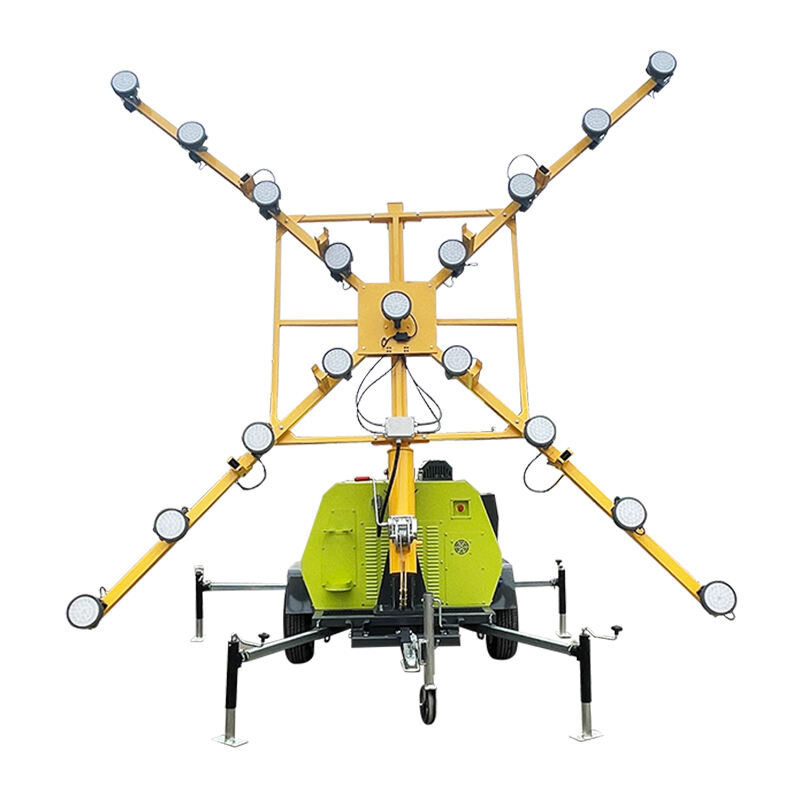مركبة الإضاءة المتنقلة 4TN4000B: لافتة إغلاق مدرج المطار وحل الأمان
نظرة عامة على مركبة الإضاءة المتنقلة 4TN4000B
تصميم مقروء للسرعة في التنفيذ
تأتي معدات الإضاءة 4TN4000B بتصميم مثبت على مقطورة ما يجعل عملية الإعداد والتحرك سريعة للغاية، مما يقلل من وقت التوقف عندما تحتاج المدرجات إلى صيانة أو إصلاح. ما يميز هذا التصميم هو أنه يمكن سحب مجموعة الإضاءة بالكامل إلى مواقع مختلفة بسهولة. وهذا يعني أن الفرق تكون جاهزة للتحرك في أي وقت تحدث فيه مشكلة في المطار، وهو أمر معروف بأنه بالغ الأهمية لضمان سلامة الرحلات الجوية. كما يتميز النظام بوجود وظيفة للتسوية التلقائية، مما يحافظ على ثباته حتى لو لم تكن الأرضية مستوية تمامًا. ويساعد هذا في منع حدوث تلك التأخيرات المحبطة الناتجة عن عدم عمل المعدات بشكل صحيح بسبب وضعها في موقع مائل.
لوحة إغلاق المدرج بـ LED عالي الكثافة
يتميز الطراز 4TN4000B بإشارات LED ذات الشدة العالية التي تضمن رؤية الطيارين تحذيرات إغلاق المدرج حتى في ظروف الطقس غير المواتية. تُضيء هذه المصابيح LED بشكل أكثر سطوعًا من المصابيح القياسية مع استهلاكها كهرباء أقل بكثير، مما يقلل من تكاليف الكهرباء للمطارات. وبحسب بحث حديث أجرته إدارة الطيران الفيدرالية (FAA)، فإن التحسن في الرؤية يلعب دورًا كبيرًا، حيث أظهرت النتائج أن تحسين العلامات الإرشادية يقلل حوادث دخول المدرج غير المصرح بها بنسبة تقارب 35%. عند تركيب هذه الوحدات في المطارات، فإنها توفر فائدة مزدوجة: تسير العمليات بشكل أكثر سلاسة خلال فترات الصيانة، ويقل البصمة الكربونية بشكل ملحوظ مقارنةً بحلول الإضاءة الأقدم التي ما زالت تُستخدم في العديد من المنشآت في أنحاء البلاد.
البناء الصلب لعمليات تعمل في جميع الأحوال الجوية
تم بناء 4TN4000B بمتانة عالية بحيث يمكنه تحمل أي شيء تُلقيه عليه الطبيعة خلال فصول الشتاء القاسية أو الصيف الحار. لقد استخدمنا مواد مقاومة للطقس بشكل مكثف لضمان استمرار عمل هذا النظام المتنقل للإضاءة في الأوقات الأكثر أهمية، سواء كان هناك أمطار غزيرة، أو عواصف ثلجية، أو هبوب رياح شديدة على الموقع. تواصل فرق العمل في الميدان إخبارنا بأنهم يحتاجون إلى معدات لا تتوقف عن العمل، وبالصراحة، من منا يريد أن تطفئ أضواءه بسبب عاصفة مفاجئة؟ هذا النوع من الموثوقية يُحدث فرقاً كبيراً في الحفاظ على سير العمليات بسلاسة حتى في الظروف الصعبة.
المصدر(power supply) المتكامل وميزات الحركة
تأتي الموديل 4TN4000B مزودة بنظام طاقة متكامل يضمن استمرارية التشغيل دون أي انقطاع، مما يعني أن الإضاءة تظل قيد التشغيل في الأوقات الأكثر أهمية خلال لحظات المدرج الحرجة. وللتغلب على مختلف أنواع التضاريس، تحتوي هذه الآلة على إطارات قوية تتناسب مع جميع التضاريس بالإضافة إلى تصميم وصل يسهل عملية السحب ويجعل المناورة في الأماكن الضيقة أسهل بكثير مقارنة بالمعدات القياسية. أشار خبراء السلامة في الطيران مرارًا إلى مدى أهمية الطاقة الموثوقة في الحفاظ على ظروف الإضاءة المناسبة في المطارات. ففي النهاية، لا أحد يرغب في التعامل مع انقطاعات مفاجئة أثناء إقلاع الطائرات أو هبوطها. مجتمعة، تحول هذه المزايا الموديل 4TN4000B إلى أكثر من مجرد قطعة معدات عادية، لتصبح أداة ضرورية تقريبًا لضمان السلامة في المطارات وسير العمليات بشكل موثوق به يومًا بعد يوم.
دور حاسم في سلامة مدرج المطار
منع الاقتحامات أثناء الفترات المغلقة
تعد شاحنات الإضاءة المتنقلة ضرورية تمامًا لتحديد مسارات إغلاق المدرجات بحيث لا يقترب أحد من الأماكن التي لا ينبغي أن يكون فيها. نشهد العديد من الحوادث كل عام فقط لأن عدد الإضاءة غير كافٍ أو لأن الإضاءة الموجودة لا تعمل بشكل صحيح في الليل. تشير بيانات سلامة الطيران إلى أن الأخطاء أثناء حالات الطوارئ تنخفض بشكل كبير عندما يتمكن الطيارون من رؤية ما يحدث فعليًا، مما يعزز بالطبع السلامة العامة بشكل كبير. كما أن تحسين الرؤية ليس مجرد ترف، بل يقلل بشكل كبير من الانتهاكات الخطرة للمدرجات، ولذلك يستمر الاستثمار في أنظمة إضاءة أقوى في جميع المطارات كجزء من البروتوكولات الأساسية للسلامة.
رؤية 24/7 للموظفين على الأرض والطيارين
توفر المركبة رؤية جيدة لطواقم الأرض والطيارين على مدار اليوم، سواء كانت الطيور تحلق نهارًا أو ليلاً، مما يجعل العمليات بشكل عام أكثر أمانًا. وغالبًا ما يشير أفراد الطواقم الأرضية إلى أهمية الإضاءة المناسبة حقًا عند التحرك حول الطائرة وقياد المركبات بأمان، خاصة عندما تكون الظروف الجوية ضبابية أو مظلمة بالخارج. وتحتوي اللوائح على متطلبات بأن تظل هذه الأنوار مضاءة على مدار الساعة في المطارات، حتى لا تنخفض معايير السلامة. وتحقيق رؤية مستمرة يساعد بالفعل في سير الأمور بسلاسة أكبر في أوقات الذروة في المطار، مثل عندما تصل وتغادر طائرات متعددة في نفس الوقت.
إضافة لأنظمة الإضاءة الدائمة
تعمل مركبات الإضاءة المتنقلة كإحتياطي لأنظمة الإضاءة العادية في المطارات، مما يمنح المشغلين شيئاً مرناً يمكنهم التحرك فيه عند الحاجة. يظلّ خبراء الطيران يشيرون إلى أنّ إدخال هذه الأضواء المحمولة معقول أثناء الصيانة الروتينية لأضواء المدرج الرئيسية حتى يظلّ كلّ شيء يعمل بسلاسة. تظهر أمثلة حقيقية من المراكز الدولية الرئيسية أن الإعدادات المؤقتة مثل وحدات الإضاءة المتنقلة تساعد في الواقع في توزيع عبء العمل خلال أوقات الازدحام في المطارات دون تعريض سلامة أي شخص للخطر. هذه الخيارات الإضاءة الإضافية تعني أن المطارات لا يجب أن تغلق تماما عندما يكون هناك مشكلة مع البنية التحتية الإضاءة القياسية، والحفاظ على الأمور تعمل بأمان معظم الوقت على الرغم من أنه في بعض الأحيان لا يزال هناك تحديات مع مشاكل الرؤية.
الميزات التقنية الرئيسية
إضاءة متوافقة مع نظارات الرؤية الليلية NVG للاستخدام العسكري
يمثل إضافة أضواء متوافقة مع نظارات الرؤية الليلية إلى شاحنات الإضاءة المتنقلة خطوة كبيرة إلى الأمام في سعي دعم العمل العسكري ليلاً. تتماشى هذه الأضواء الخاصة مع المواصفات العسكرية الحالية الخاصة بالعمل في الظروف ذات الإضاءة المنخفضة، مما يجعلها أكثر أماناً لاستخدامها من قبل القوات التي تحتاج إلى التحرك بعد حلول الظلام. ويؤكد الخبراء في مجال الطيران، والذين يتعاملون بشكل منتظم مع المجال الجوي العسكري والتجاري، على أهمية الإضاءة المرنة في هذه المناطق المختلطة. إن القدرة على تعديل مستويات السطوع تساعد في منع وقوع الحوادث بين أنواع مختلفة من الطائرات التي تحلق في نفس المنطقة، وفي الوقت نفسه تضمن الحفاظ على فعالية المهمة أثناء تنفيذ المهام المعقدة ليلاً.
تشغيل بطاريات موفرة للطاقة
تتميز مركبات الإضاءة المتنقلة المزودة ببطاريات ذات كفاءة في استخدام الطاقة بعدة فوائد، ويرجع ذلك إلى حد كبير إلى استهلاكها المنخفض للطاقة، مما يعني أن هذه الوحدات تظل قيد التشغيل لفترات أطول دون الحاجة إلى الشحن. وتجد المطارات التي تسعى إلى تقليل تأثيرها البيئي أن الأنظمة التي تعمل بالبطاريات مفيدة بشكل خاص في تحقيق أهداف العمليات الخضراء. وتشير دراسات من تقارير صناعية إلى أنه عندما تتحول المطارات إلى هذه الأنظمة الفعالة، فإنها تلاحظ في كثير من الأحيان انخفاضًا ملحوظًا في المصروفات التشغيلية على المدى الطويل، وهو أمر يُحدث فرقًا حقيقيًا في الميزانيات السنوية. كما أن الاتجاه نحو العمليات الخضراء ليس مفيدًا فقط للبيئة، بل إنه يوفر المال على المدى الطويل أيضًا، مما يجعله خيارًا ذكيًا لمديري المطارات ذوي التفكير المستقبلي الذين يسعون لتحقيق الاستدامة وتوفير التكاليف في آنٍ واحد.
قدرات التحكم عن بعد اللاسلكي
أصبحت تقنية التحكم عن بُعد اللاسلكية معيارًا في شاحنات الإضاءة المتنقلة الحديثة، مما يجعل مواقع العمل أكثر أمانًا للجميع. يمكن للمُشغلين الآن تعديل الإضاءة دون الحاجة إلى السير فعليًا في مناطق خطرة قد تكون قريبة من حركة طائرات تسير على المدرج. يشير خبراء السلامة الجوية إلى أن أجهزة التحكم عن بُعد الأفضل تعني استجابةً أسرع عندما تحدث مشكلات، وهو أمر بالغ الأهمية خلال المواقف غير المتوقعة في المطارات المزدحمة. تقلل هذه الأنظمة من عوامل الخطر مع الحفاظ على سير العمليات بسلاسة، ولهذا السبب تستثمر العديد من سلطات المطارات بشكل كبير في هذه التقنية رغم التكاليف الأولية. والفوائد الواقعية تتحدث عن نفسها في النهاية.
التوافق مع معايير الطيران
الامتثال لدورة الاستشارة الخاصة بـ FAA 150/5345-46D
الالتزام بالنشرة الاستشارية الإتحادية للطيران (FAA Advisory Circular) 150/5345-46D ليس مجرد ممارسة جيدة، بل هو ضروري إذا أرادت المطارات الحفاظ على سير عملياتها بسلاسة. يحدد هذا المستند جميع المتطلبات الفنية لأنواع مختلفة من إضاءة المطارات، بدءًا من علامات ممرات التحرك (Taxiway) وصولًا إلى أنظمة الإرشاد للهبوط. عندما تتبع المطارات هذه المواصفات التفصيلية، فإنها تحصل على أداء أفضل من تركيبات الإضاءة المؤقتة في حين تضمن وضوح الرؤية أمام الطيارين ليلاً أو في ظروف الطقس السيئ. أظهرت الأبحاث المتعلقة بكيفية عمل المطارات أنه عندما تتبع المنشآت هذه المعايير فعليًا، تقل الحوادث على المدرجات. وهذا يعني أن الطائرات تقلع وت land بسلام أكثر، مما يؤدي في النهاية إلى توفير المال والحفاظ على حركة المسافرين عبر النظام دون تأخيرات غير ضرورية.
متطلبات الرؤية وفق الملحق 14 لمنظمة الطيران المدني الدولي (ICAO)
يلعب الالتزام بمعايير الرؤية المنصوص عليها في المرفق 14 لمنظمة الطيران المدني الدولي (ICAO) دوراً كبيراً بالنسبة للمطارات الدولية التي ترغب في الالتزام بالقواعد التشغيلية العالمية. تضمن هذه التنظيمات بشكل أساسي أن تعمل أنظمة الإضاءة في المطارات بشكل صحيح وفقاً للمعايير الأمنية التي تحددها الدول والهيئات المعترف بها عالمياً. لاحظ خبراء السلامة مراراً وتكراراً أنه عندما لا تلتزم المطارات بهذه الإرشادات، ترتفع معدلات الحوادث بشكل كبير. فكّر في مدارج الطائرات التي يواجه فيها الطيارون صعوبة في رؤية العلامات الخاصة بها في الليل أو أثناء الظروف الجوية السيئة. هذا هو السبب في أن معظم المطارات الجادة تستثمر بشكل كبير في أنظمة إضاءة مناسبة تلتزم بشكل قاطع بهذه المتطلبات.
معايير إضاءة المطارات الدولية
الالتزام بالمعايير الدولية لإضاءة المطارات ليس مجرد ممارسة جيدة، بل هو ضرورة مطلقة إذا أراد المطارات العمل بأمان معًا في جميع أنحاء العالم. عندما تلتزم المطارات بهذه الإرشادات، فإنها تسهل تبادل المعدات وقطع الغيار والمعرفة مع المطارات الأخرى على مستوى العالم. يتم تحديث هذه القواعد بشكل دوري مع ظهور التكنولوجيا الجديدة والتغير في متطلبات السلامة. هذا يعني أن المطارات ليست مضطرة لاستخدام أنظمة قديمة، بل تبقى على اطلاع دائم بأحدث الابتكارات في تكنولوجيا الإضاءة مع الحفاظ على مستويات عالية من السلامة لجميع الأطراف المعنية.
المزايا التشغيلية وحالات الاستخدام
سيناريوهات إغلاق المدرج الطارئة
عندما تسوء الأمور ليلاً أو أثناء سوء الأحوال الجوية، فإن نشر الإضاءة المتنقلة بسرعة على المدرجات يُحدث فرقاً كبيراً من حيث السلامة والإشارات المناسبة. يعرف موظفو المطارات هذا من خبرتهم بعد التعامل مع إغلاقات غير متوقعة على مدار السنين. فعلى سبيل المثال، شهد مطار أوهير في شيكاغو تقلصاً في الحوادث خلال الشتاء الماضي عندما دخل نظام الإضاءة الاحتياطي في الخدمة خلال دقائق من حدوث عطل في التيار الكهربائي. كما أن التعاون الوثيق مع رجال الإطفاء والمسعفين مهم أيضاً. يمكن نشر شاحنات الإضاءة المثلى خلال أقل من عشر دقائق، ويمكن نقلها بسهولة إلى الأماكن التي يُحتاج إليها بشدة، مما يوفر وقتاً ثميناً يكون فيه كل ثانية مهمة أثناء حالة هبوط طارئ.
حلول صيانة المسارات المؤقتة
تُعد صيانة ممرات المطارات من العوامل التي تُسبب العديد من المشكلات التشغيلية للمطارات. وهنا تظهر أهمية استخدام شاحنات الإضاءة المتنقلة، حيث توفر قدرًا كافيًا من الإضاءة لمواصلة حركة الطائرات في الوقت الذي تتم فيه الإصلاحات تحت أجنحتها مباشرة. فعند الحاجة إلى إصلاح الممرات، تُحدث الإضاءة المناسبة فرقًا كبيرًا في الحفاظ على سير العمليات دون اللجوء إلى إغلاق تام. تُظهر البيانات الصادرة عن القطاع أن هذه الإضاءة المتنقلة تُسهم في تحقيق وفورات مالية، إذ تقلل من مدة إغلاق المطارات أثناء أعمال الصيانة. وتشير تقارير من مطارات في جميع أنحاء البلاد إلى تحسن في النتائج عند استخدام حلول الإضاءة هذه خلال فترات الإصلاح الحرجة. بدلًا من إغلاق أقسام كبيرة من المطار لعدة أيام متواصلة، يمكن للفرق الآن إصلاح الأعطال خلال الليل بينما تستمر الرحلات الجوية بشكل طبيعي في النهار.
استراتيجيات نشر الأسطول متعدد المطارات
تشغيل مجموعة من الشاحنات المتنقلة للإضاءة في عدة مطارات يجعل العمليات أكثر كفاءة ويتيح توفير الإضاءة بسرعة عند الحاجة. مع أنظمة التحكم المركزية، يمكن إرسال وحدات الإضاءة هذه إلى الأماكن التي تتطلبها فعليًا في الوقت الحالي بدلًا من أن تظل غير مستخدمة في مكان آخر. تشير الأبحاث إلى أنه عندما ينسق المطارات أسطول الإضاءة الخاص بهم بشكل صحيح، تزداد السلامة ويحصل الأشخاص على الإضاءة التي يحتاجونها دون تأخير. ويقلل هذا من المواقف المحبطة التي يصعب فيها العثور على ضوء يعمل أثناء حالة طوارئ. بالنسبة لمديري المطارات، فإن امتلاك هذا النوع من الأنظمة يعني الوصول المتسق إلى معدات الإضاءة المناسبة في أي مكان مطلوب ضمن شبكة المرافق التابعة لهم.
 EN
EN
 AR
AR CS
CS DA
DA NL
NL FI
FI FR
FR DE
DE IT
IT NO
NO KO
KO PL
PL PT
PT RO
RO RU
RU ES
ES SV
SV TL
TL ID
ID LV
LV SR
SR SK
SK SL
SL VI
VI SQ
SQ ET
ET TH
TH TR
TR AF
AF MS
MS GA
GA HY
HY KA
KA BS
BS LA
LA MN
MN MY
MY KK
KK UZ
UZ KY
KY








